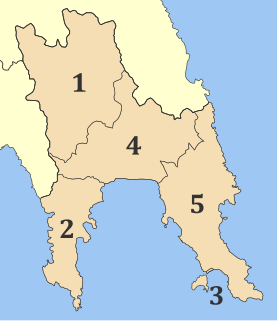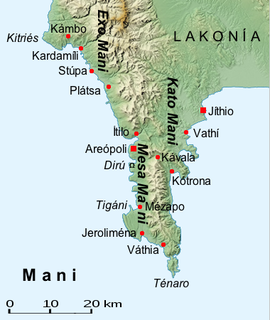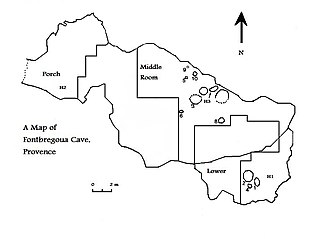
Laconia is a region of Greece in the southeastern part of the Peloponnese peninsula. Its administrative capital is Sparta. The word laconic is derived from the name of the region by analogy—to speak in a concise way, as the Spartans were reputed by the Athenians to do.

The Mani Peninsula, also long known by its medieval name Maina or Maïna (Μαΐνη), is a geographical and cultural region in southern Greece that is home to the Maniots, who claim descent from the ancient Spartans. The capital cities of Mani are Gytheio and Areopoli. Mani is the central peninsula of the three which extend southwards from the Peloponnese in southern Greece. To the east is the Laconian Gulf, to the west the Messenian Gulf. The Mani peninsula forms a continuation of the Taygetos mountain range, the western spine of the Peloponnese.

Sesklo is a village in Greece that is located near Volos, a city located within the municipality of Aisonia. The municipality is located within the regional unit of Magnesia that is located within the administrative region of Thessaly.

Franchthi Cave or Frankhthi Cave is an archaeological site overlooking Kiladha Bay, in the Argolic Gulf, opposite the village of Kiladha in southeastern Argolis, Greece.

Cape Matapan, also named as Cape Tainaron, or Cape Tenaro, is situated at the end of the Mani Peninsula, Greece. Cape Matapan is the southernmost point of mainland Greece, and the second southernmost point in mainland Europe. It separates the Messenian Gulf in the west from the Laconian Gulf in the east.
Pyrgos Dirou is a town in Mani, Laconia, Greece. It is part of the municipal unit of Oitylo. It is around 26 kilometres from Areopoli.
The year 1978 in archaeology involved some significant events.
Adamantios Sampson is a Greek archaeologist. He worked as an Inspector of Antiquities for the Greek Administration of Antiquity. He is specialised in research on prehistoric Neolithic and Mesolithic sites in southern Greece. Among the sites he has studied are the "Cave of Cyclope" on the islet of Youra near Alonissos in the Νοrthern Sporades; the islet of Υali near Nisyros; the site Maroulas on Kythnos island; the site Kerame on Ikaria island; Sarakenos Cave on Boeotia; the cave "Skoteini" in Euboea; the "Cave of the Lakes" near Kalavryta in the Peloponnese and many other sites in Euboea and Dodecanese. Among his best-known finds are the so-called Youra Potsherds, prehistoric pottery fragments incised with markings that some people believe resemble letters of the Greek alphabet. Since 1999 professor in the University of the Aegean, Department of Mediterranean Studies, Rhodes.

Hajji Firuz Tepe is an archaeological site located in West Azarbaijan province in north-western Iran and lies in the north-western part of the Zagros Mountains. The site was excavated between 1958 and 1968 by archaeologists from the University of Pennsylvania Museum of Archaeology and Anthropology. The excavations revealed a Neolithic village that was occupied in the second half of the sixth millennium BC where some of the oldest archaeological evidence of grape-based wine was discovered in the form of organic residue in a pottery jar.

Parc Cwm long cairn, also known as Parc le Breos burial chamber, is a partly restored Neolithic chambered tomb, identified in 1937 as a Severn-Cotswold type of chambered long barrow. The cromlech, a megalithic burial chamber, was built around 5850 years before present (BP), during the early Neolithic. It is about seven 1⁄2 miles (12 km) west south–west of Swansea, Wales, in what is now known as Coed y Parc Cwm at Parc le Breos, on the Gower Peninsula.

Parc le Breos was a great medieval deer park in the south of the Gower Peninsula, about eight miles (13 km) west of Swansea, Wales, and about 1 1⁄4 miles (2.0 km) north of the Bristol Channel. The park was an enclosed, oval area of 6.7 miles (10.8 km) in circumference, covering about 2,000 acres (810 ha) and measuring 2 1⁄2 miles (east–west) by just over 1 3⁄4 miles. Parc le Breos was established in the 1220s CE by John de Braose, Marcher Lord of Gower and husband to Margaret Ferch Llywelyn, Llywelyn Fawr's daughter. Other than for deer husbandry, the park received an income from agistment, pannage, and from sales of wild honey, ferns and dead wood. There is evidence of rabbit warrens in the park. Whether the warrens were free or domestic is unknown.

Neolithic Greece is an archaeological term used to refer to the Neolithic phase of Greek history beginning with the spread of farming to Greece in 7000–6500 BC. During this period, many developments occurred such as the establishment and expansion of a mixed farming and stock-rearing economy, architectural innovations, as well as elaborate art and tool manufacturing. Neolithic Greece is part of the Prehistory of Southeastern Europe.

Fontbrégoua Cave is an archaeological site located in Provence, Southeastern France. It was used by humans in the fifth and fourth millennia BCE, in what is now known as the Early and Middle Neolithic. A temporary residential site, it was used by Neolithic agriculturalists as a storage area for their herds of goats and sheep, and also contained a number of bone depositions, containing the remains of domestic species, wild animals, and humans. The inclusion of the latter of these deposits led the archaeological team studying the site to propose that cannibalism had taken place at Fontbrégoua, although other archaeologists have instead suggested that they represent evidence of secondary burial.
The Baum Site (31Ck9) is one of the most prominent Middle and Late Woodland Period sites of the Colington Phase in the state of North Carolina. It is located north of Poplar Branch in Currituck County, North Carolina. This phase, marked by cultures of the Algonkian peoples, aligns with the Late Woodland period in North Carolina, occurring during English explorations between 1584 and 1587, and permanent settlement at 1650. This village is what the first English explorers encountered when entering the coastal region. The site contained ossuaries and evidence for a coastal village adaptation. The site was registered with the National Register of Historic Places on December 8, 1982, after testing and excavations in 1972 and 1973 by David Sutton Phelps, who was an archaeologist at East Carolina University. The site is suffering from erosion due to wave action. After the initial discovery, which was the result of erosion uncovering of remains, Phelps claimed, “this will provide the first glimpse of a coastal village of this type in the state”. A residential subdivision, Currituck Crossing, is now located on the Baum site. https://web.archive.org/web/20160617035403/http://co.currituck.nc.us/pdf/board-of-commissioners-minutes-2013/boc-minutes-13nov04.pdf.
The Temple of Poseidon at Tainaron is on the extreme point of the Mani Peninsula, the middle finger of the Peloponnese peninsula. Strabo described the sanctuary as a sacred grove with a nearby cave, The geographer Pausanias wrote of a cave like temple with a statue to Poseidon at its entrance. In antiquity, the cave was thought to be the entrance to Hades. When Sparta was devastated by an earthquake in 464 BC, it was said that the cause had been Poseidon's vengeance on the Spartan ephors after they had killed helots who had taken refuge at the sanctuary. It is thought that the sanctuary at Tainaron dates at least to a time when the helots were still independent, before they had been subjugated by Sparta.
Qafzeh cave means “precipice”, also known as Kedumim cave or Ha'kfitza cave, is a prehistoric archaeological site located at the bottom of Mount Precipice, in the Yizrael Valley of the Lower Galilee, south of Nazareth. Important remains of prehistoric people were discovered on the site - some of the oldest examples in the world, outside of Africa, of virtually anatomically modern human beings. These were discovered on the ledge just outside the cave, where 18 layers from the Middle Paleolithic era were identified. The interior of the cave contains layers ranging from the Neolithic era to the Bronze age.
The Pigi Athinas is an archaeological site at the eastern foot of Mount Olympus, near the village of Platamonas.
At the site Valtos Leptokaryas settlement remains from different periods of the Bronze Age and Christianity were discovered. The place was inhabited for centuries.
The area currently known as the United Arab Emirates (UAE) was formerly populated by inhabitants of a number of coastal and inland settlements, with human remains pointing to a pattern of transmigration and settlement as far back as 125,000 years. Prehistoric settlement in the UAE spanned the Neolithic, with a number of distinctive eras of ancient settlement including the Stone Age Arabian Bifacial and Ubaid cultures from 5,000 to 3,100 BCE; the Hafeet period with its distinctive beehive shaped tombs and Jemdet Nasr pottery, from 3,200 to 2,600 BCE; the Umm Al Nar period from 2,600 to 2,000 BCE; the Wadi Suq Culture from 2,000–1,300 BCE and the three Iron Ages of the UAE.
Archaeology of Greece includes artificial remains, geographical landscapes, architectural remains, and biofacts. The history of Greece as a country and region is believed to have begun roughly 1–2 million years ago when Homo erectus first colonized Europe. From the first colonization, Greek history follows a sequential pattern of development alike to the rest of Europe. Neolithic, Bronze, Iron and Classical Greece are highlights of the Greek archaeological record, with an array of archaeological finds relevant to these periods.










